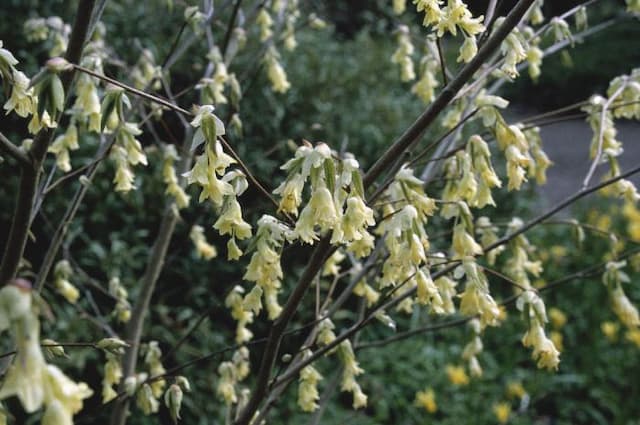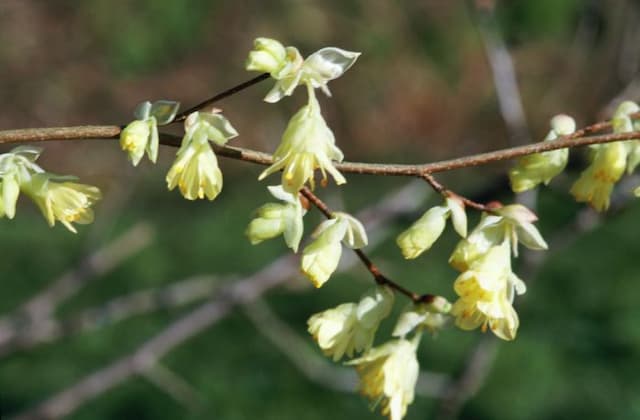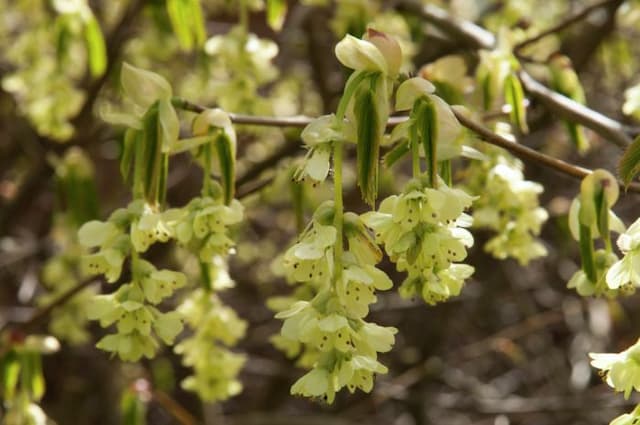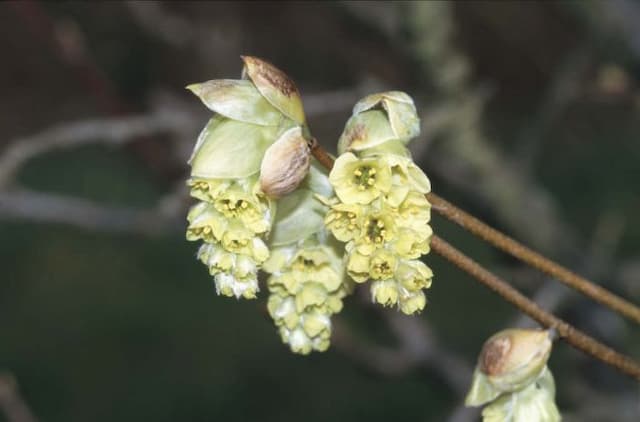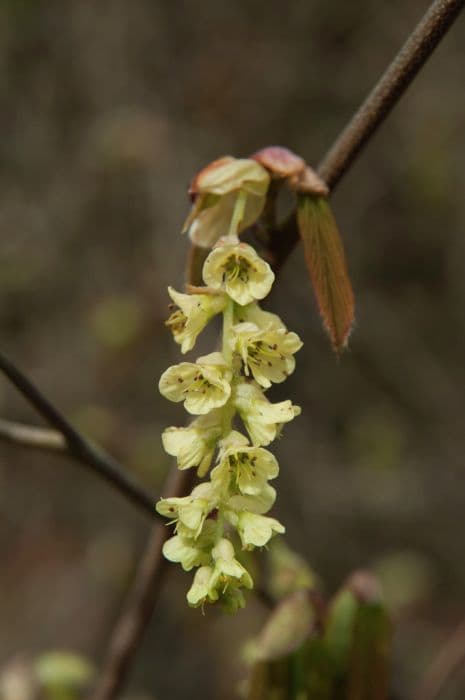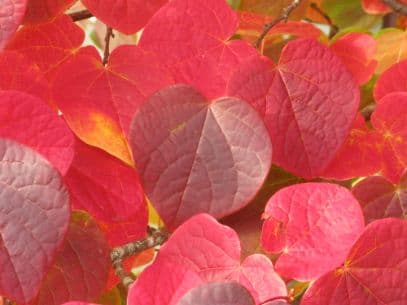Witch Hazel Hamamelis × intermedia 'Burning Desire'

ABOUT
The Hamamelis × intermedia 'Burning Desire', commonly known as the witch hazel 'Burning Desire', is a captivating plant primarily known for its vibrant, colorful foliage and distinct flowers. This witch hazel variant displays a fiery array of leaf colors that includes shades of green, yellow, orange, and red, often all present at the same time, which gives the plant its name 'Burning Desire'. The leaves themselves are broadly oval to obovate with a softly serrated edge, which turns more intensely colored as the cooler weather arrives in the fall. In addition to the striking autumnal foliage, this witch hazel produces unique flowers. The blooms are ribbon-like with crinkly, strap-shaped petals that burst forth in clusters along the branches. These flowers are typically a bright yellow to orange color, adding a splash of warmth during the late winter to early spring when few other plants are in bloom. The branches of the Burning Desire witch hazel tend to spread outwards and can create a somewhat irregular shape, giving the plant a naturalistic, even slightly unkempt appearance. This visual texture adds interest to the landscape during all seasons. The bark is smooth and provides a subtle backdrop to the more colorful characteristics of the leaves and flowers. Overall, the witch hazel 'Burning Desire' is known for these beautifully vibrant colors and distinctive, fragrant flowers that catch the eye in the winter garden when little else is in bloom. It's a visually fascinating plant that brings bursts of color throughout the year, with a peak display that coincides with the colder months, offering beauty when it's often most needed.
About this plant
 Names
NamesFamily
Hamamelidaceae
Synonyms
Witch Hazel, Hybrid Witch Hazel, Burning Desire Witch Hazel
Common names
Hamamelis × intermedia 'Burning Desire'.
 Toxicity
ToxicityTo humans
Witch hazel 'Burning Desire' is generally considered non-toxic to humans. It is not known to contain any components that would typically cause poisoning when ingested. However, it is always advisable to avoid eating ornamental plants as a general precaution. If large amounts were ingested and symptoms such as gastrointestinal discomfort or allergic reactions occur, medical advice should be sought.
To pets
Witch hazel 'Burning Desire' is also generally considered non-toxic to pets. It should not cause any symptoms of poisoning in pets if they happen to ingest small amounts of the plant. As with humans, it is generally recommended to prevent pets from consuming plants that are not intended for consumption to avoid potential gastrointestinal upset or other unexpected reactions. If a pet ingests a large amount of the plant and shows signs of distress, contact a veterinarian.
 Characteristics
CharacteristicsLife cycle
Perennials
Foliage type
Deciduous
Color of leaves
Green
Flower color
Red
Height
8-12 feet (2.4-3.7 meters)
Spread
8-12 feet (2.4-3.7 meters)
Plant type
Shrub
Hardiness zones
5
Native area
Asia
Benefits
 General Benefits
General Benefits- Ornamental Value: This witch hazel variant is known for its striking flowers that provide visual interest during late winter to early spring when few other plants are in bloom.
- Scented Flowers: The plant's flowers emit a pleasant fragrance which can add an aromatic element to a garden or landscape.
- Attracts Pollinators: It serves as a source of nectar for pollinators such as bees during a time of year when few other food sources are available.
- Seasonal Interest: Witch hazel provides year-round interest with its unique flowers, attractive fall foliage, and distinctive seed capsules.
- Durable: It is generally adaptable to a variety of soil conditions and can tolerate some degree of urban pollution.
- Low Maintenance: Once established, witch hazel requires minimal care, making it a great choice for gardeners seeking low-maintenance plants.
- Cold Hardy: This plant is capable of withstanding cold temperatures, making it suitable for growing in a range of climates.
 Medical Properties
Medical PropertiesThis plant is not used for medical purposes.
 Air-purifying Qualities
Air-purifying QualitiesThis plant is not specifically known for air purifying qualities.
 Other Uses
Other Uses- Photography: The vivid red and orange autumn leaves of Witch Hazel can be used as a stunning backdrop for outdoor photography, enhancing the natural colors in the shot.
- Art Supplies: The branches and bark of Witch Hazel may be used in the production of charcoal for drawing and sketching.
- Dyeing Fabric: The tannins and colorants in the leaves and bark can be boiled to create a natural dye for fabrics, yielding warm earth tones.
- Natural Insect Repellant: Some gardeners use Witch Hazel twigs in a homemade insect spray, believing the natural compounds can deter pests.
- Wreath Making: Branches of Witch Hazel, particularly when they are in bloom with their unique yellow flowers, can be woven into decorative wreaths.
- Culinary Garnish: While not widely known for its culinary uses, the flowers can be used as an edible garnish to add color to salads and desserts.
- Floral Arrangements: The unusual spider-like flowers and the structure of the branches can provide an exotic touch to floral arrangements.
- Crafting Jewelry: The small branches and seed pods can be incorporated into handmade jewelry, such as pendants and earrings.
- Eco-friendly Confetti: Dried Witch Hazel petals can be used as a biodegradable confetti for festive occasions, reducing the environmental impact of traditional plastic confetti.
- Garden Structures: Flexible Witch Hazel branches can be used in the garden to create natural supports or trellises for climbing plants.
Interesting Facts
 Feng Shui
Feng ShuiThe Witch Hazel is not used in Feng Shui practice.
 Zodiac Sign Compitability
Zodiac Sign CompitabilityThe Witch Hazel is not used in astrology practice.
 Plant Symbolism
Plant Symbolism- Healing: Hamamelis, commonly known as Witch Hazel, is well-known for its medicinal properties, and can thus symbolize healing and soothing of ailments.
- Protection: Witch Hazel has been used for protection in folklore, often associated with warding off negative energies and bringing good fortune.
- Uniqueness: The 'Burning Desire' variety, with its distinctive red to orange flowers, symbolizes uniqueness and standing out from the crowd.
- Hope: Flowering in late winter, Witch Hazel represents hope and the promise of spring amidst the cold.
- Purity: The cleansing properties of Witch Hazel can be associated with purity and renewal.
 Water
WaterWitch Hazel 'Burning Desire' requires consistent moisture, especially during the first growing season to establish a deep, extensive root system. Water the plant deeply once a week, providing about 1-2 inches of water or roughly 0.5-1.5 gallons, depending on the soil type and weather conditions. Make sure the soil is well-drained, and the plant does not sit in waterlogged soil. In periods of drought or extreme heat, increase the frequency of watering to keep the soil consistently moist, but never waterlogged.
 Light
LightWitch Hazel 'Burning Desire' thrives in full sun to partial shade. A location that receives morning sunlight with some afternoon shade is ideal for maintaining vibrant foliage without causing sunburn. Avoid deep shade as it can lead to fewer blooms and a leggy growth habit.
 Temperature
TemperatureWitch Hazel 'Burning Desire' prefers temperatures between 30°F and 90°F. It can withstand cold down to around 0°F; however, temperatures below this can cause damage. The ideal range for this plant is from 60°F to 75°F during its active growing period.
 Pruning
PruningPrune Witch Hazel 'Burning Desire' in late winter or early spring after the flowers have faded to maintain its shape and remove any dead or diseased wood. Pruning can also stimulate new growth, and it is the best time to do so as it minimizes stress on the plant. Pruning every year or every other year is typically adequate.
 Cleaning
CleaningAs needed
 Soil
SoilWitch Hazel 'Burning Desire' thrives in well-draining, fertile soil with a slight acidity to neutral pH range of 5.5 to 7. A good soil mix for this plant should consist of loam, peat, and sharp sand to facilitate proper drainage and aeration. Adding organic material like compost will enrich the soil and benefit the plant's growth, ensuring that it has all the nutrients it needs.
 Repotting
RepottingWitch Hazel 'Burning Desire' generally does not require frequent repotting as it is typically grown as a large shrub or small tree outdoors. However, if grown in containers, it should be repotted when it becomes root-bound or every 3 to 5 years to refresh the soil and expand its growing space.
 Humidity & Misting
Humidity & MistingWitch Hazel 'Burning Desire' is adaptable to a range of humidity levels, but it prefers average to high humidity conditions. It does not require any special humidity considerations when planted in the garden, as it is quite tolerant of the varying humidity levels found in most temperate climates.
 Suitable locations
Suitable locationsIndoor
Place in bright, indirect light; water when topsoil is dry.
Outdoor
Full sun to partial shade; protect from strong winds.
Hardiness zone
5-8 USDA
 Life cycle
Life cycleThe life of Hamamelis × intermedia 'Burning Desire', commonly known as Witch Hazel 'Burning Desire', begins with seed germination, typically occurring in spring when temperatures become suitable for growth. Seedlings develop into juvenile plants, establishing a root system and foliage through photosynthesis. As they mature, Witch Hazel 'Burning Desire' plants enter the vegetative stage, where they continue to grow in size and strength, developing woody stems and larger, more profuse leaves. During this stage, they may also be pruned to shape the plant and encourage more dense growth. Upon reaching maturity, these plants enter the reproductive phase, which is characterized by the production of fragrant, yellow to red flowers typically in late winter to early spring, often while the plant is still leafless. Following pollination, seeds are produced and dispersed, completing the cycle, while the mature plant continues to grow and flower annually for many years.
 Propogation
PropogationPropogation time
Late winter to early spring
Propogation: Witch Hazel 'Burning Desire' is typically propagated through softwood cuttings, which is the most popular method for this shrub. The best time to take these cuttings is in late spring or early summer when the new growth is still tender and green but has started to harden slightly. Cuttings should be about 4 to 6 inches (10 to 15 centimeters) long and include several leaf nodes. The lower leaves are removed, and the cut end is dipped in rooting hormone before being placed in a well-draining potting mix. The cutting needs to be kept in a warm, humid environment until roots develop, which can take several weeks. During this time, it's important to keep the soil consistently moist but not waterlogged.
